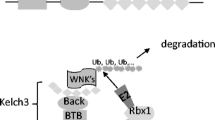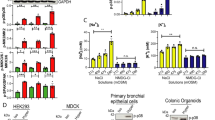Abstract
Background
Mutations of WNK kinase genes were identified as the cause of a hereditary hypertensive disease, pseudohypoaldosteronism type II; however, little is known about the regulation of WNK kinases. In the present study, we focused on anisosmotic conditions as the initial clues for clarifying a stimulating factor for WNK kinase activity.
Methods
Endogenous WNK kinase activity in COS7 cells was monitored by the phosphorylation of its substrate, OSR1.
Results
Knockdown experiments revealed that WNK1 was a major WNK kinase in COS7 cells. In contrast to the transient increase in WNK1 activity caused by hypertonic medium, hypotonic medium increased the phosphorylation of OSR1 for 24 h, suggesting that the hypotonic medium included a signal for continuously stimulating WNK1 kinase activity. To identify the signal, ion substitution experiments were performed. Surprisingly, even isotonic media with low Cl− or low K+ was found to increase OSR1 phosphorylation as well as the hypotonic medium. Furthermore, WNK1 activation by the hypotonic medium was completely blocked by quinine (500 μM) but not by 5-nitro-2-(3-phenylpropylamino) benzoic acid (100 μM), and this inhibition was closely correlated with the inhibition of 86Rb+ (=K+) efflux but not with the inhibition of 125I− (=Cl−) efflux. These results suggest that K+, rather than hypotonicity or low Cl−, may be an important regulator for WNK1 activation. Finally, we confirmed that high K+ and low K+ media under the physiological range decreased and increased WNK1 activity, respectively.
Conclusion
Extracellular K+ is an important regulator of WNK1 kinase activity.




Similar content being viewed by others
References
Wilson F, Disse-Nicodème S, Choate K, Ishikawa K, Nelson-Williams C, Desitter I, et al. Human hypertension caused by mutations in WNK kinases. Science. 2001;293:1107–12.
Yang SS, Morimoto T, Rai T, Chiga M, Sohara E, Ohno M, et al. Molecular pathogenesis of pseudohypoaldosteronism type II: generation and analysis of a Wnk4(D561A/+) knockin mouse model. Cell Metab. 2007;5:331–44.
Chiga M, Rai T, Yang S, Ohta A, Takizawa T, Sasaki S, et al. Dietary salt regulates the phosphorylation of OSR1/SPAK kinases and the sodium chloride cotransporter through aldosterone. Kidney Int. 2008;74:1403–9.
Vallon V, Schroth J, Lang F, Kuhl D, Uchida S. Expression and phosphorylation of the Na+-Cl- cotransporter NCC in vivo is regulated by dietary salt, potassium, and SGK1. Am J Physiol Renal Physiol. 2009;297:F704–12.
Yang CL, Zhu X, Ellison DH. The thiazide-sensitive Na-Cl cotransporter is regulated by a WNK kinase signaling complex. J Clin Invest. 2007;117:3403–11.
Ohta A, Rai T, Yui N, Chiga M, Yang SS, Lin SH, et al. Targeted disruption of the Wnk4 gene decreases phosphorylation of Na-Cl cotransporter, increases Na excretion, and lowers blood pressure. Hum Mol Genet. 2009;18:3978–86.
Hoffmann EK, Lambert IH, Pedersen SF. Physiology of cell volume regulation in vertebrates. Physiol Rev. 2009;89:193–277.
De Smet P, Li J, Van Driessche W. Hypotonicity activates a lanthanide-sensitive pathway for K+ release in A6 epithelia. Am J Physiol Cell Physiol. 1998;275:C189–99.
Maeno E, Ishizaki Y, Kanaseki T, Hazama A, Okada Y. Normotonic cell shrinkage because of disordered volume regulation is an early prerequisite to apoptosis. Proc Natl Acad Sci USA. 2000;97:9487–92.
Okada Y, Shimizu T, Maeno E, Tanabe S, Wang X, Takahashi N. Volume-sensitive chloride channels involved in apoptotic volume decrease and cell death. J Membr Biol. 2006;209:21–9.
Parkerson KA, Sontheimer H. Contribution of chloride channels to volume regulation of cortical astrocytes. Am J Physiol Cell Physiol. 2003;284:C1460–7.
Moriguchi T, Urushiyama S, Hisamoto N, Iemura S, Uchida S, Natsume T, et al. WNK1 regulates phosphorylation of cation-chloride-coupled cotransporters via the STE20-related kinases, SPAK and OSR1. J Biol Chem. 2005;280:42685–93.
Zagorska A, Pozo-Guisado E, Boudeau J, Vitari AC, Rafiqi FH, Thastrup J, et al. Regulation of activity and localization of the WNK1 protein kinase by hyperosmotic stress. J Cell Biol. 2007;176:89–100.
Yu SP, Yeh CH, Sensi SL, Gwag BJ, Canzoniero LM, Farhangrazi ZS, et al. Mediation of neuronal apoptosis by enhancement of outward potassium current. Science. 1997;278:114–7.
Yu SP, Yeh C, Strasser U, Tian M, Choi DW. NMDA receptor-mediated K+ efflux and neuronal apoptosis. Science. 1999;284:336–9.
Walev I, Klein J, Husmann M, Valeva A, Strauch S, Wirtz H, et al. Potassium regulates IL-1 beta processing via calcium-independent phospholipase A2. J Immunol. 2000;164:5120–4.
Acknowledgments
This study was supported in part by Grants-in-Aid for Scientific Research on Priority Areas from the Ministry of Education, Culture, Sports, Science and Technology of Japan (No. 17081009 to S.U.), Grants-in-Aid for Scientific Research (A) (No. 20249047 to S.U.) from the Japan Society for the Promotion of Science, Salt Science Research Foundation (No. 1026), and Takeda Science Foundation.
Author information
Authors and Affiliations
Corresponding author
About this article
Cite this article
Naito, S., Ohta, A., Sohara, E. et al. Regulation of WNK1 kinase by extracellular potassium. Clin Exp Nephrol 15, 195–202 (2011). https://doi.org/10.1007/s10157-010-0378-9
Received:
Accepted:
Published:
Issue Date:
DOI: https://doi.org/10.1007/s10157-010-0378-9




